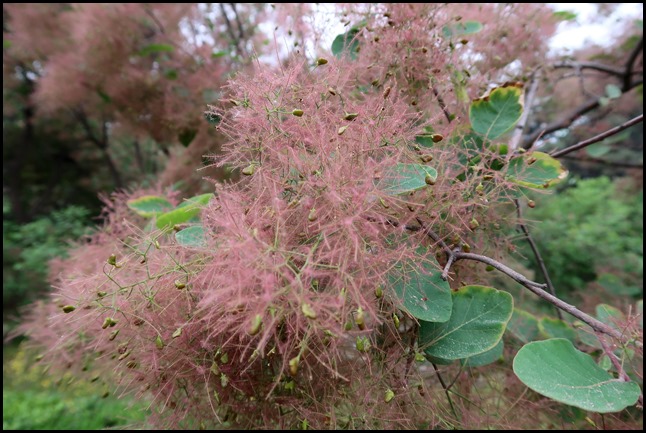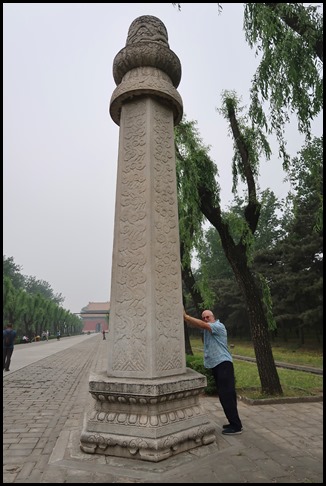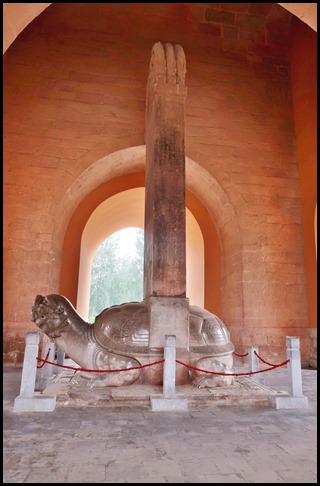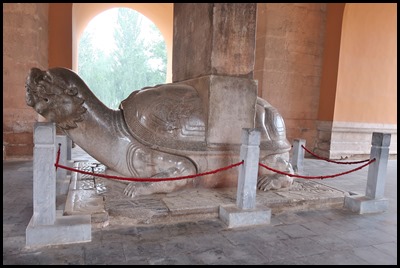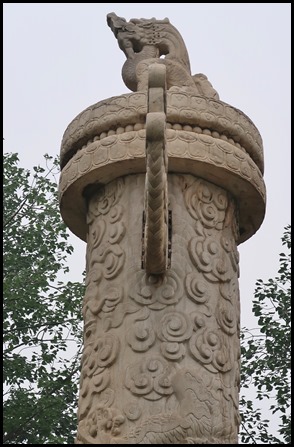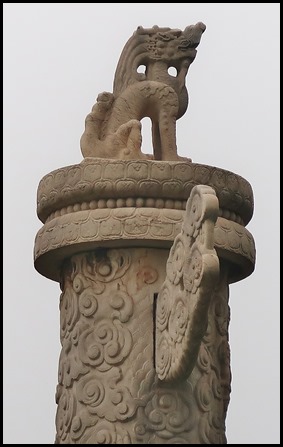The Sacred Passage

|
The Sacred Way to the Ming
Tombs
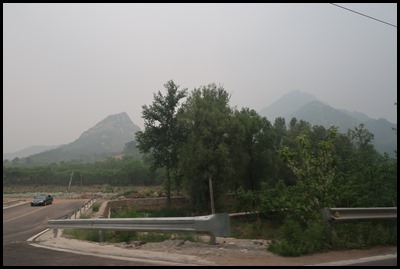 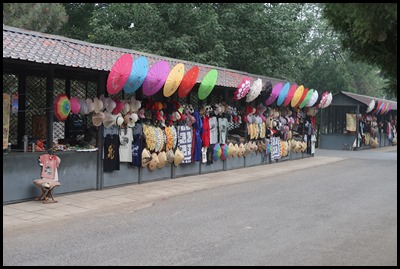 About an hour or so from Beijing and
into the countryside of farms, fruit growers and a backdrop of mist-covered hills, we arrived at The Sacred Way, but first
we had to run the gauntlet of sales ladies. As you can see from the picture, the
stalls looked deserted – one and a half
steps toward the entrance gate, cunningly placed beyond said
leviathans.......who appeared faster than lightning. It took full bravery,
nerves of steel and a keen need to say “No thank you” several times to reach the
safe zone.
 Inside the metal gate, phew, we
stopped in front of the first map to get our heart
rates back to within ‘normal’ bounds.
The information read: The Ming
Tombs. Situated at the foot of Tianshou Mountain of Changping District, Beijing,
the Thirteen Ming Tombs is the cemetery complex of the 13 emperors of the Ming
Dynasty (1368-1644). Covering an area of 80 square kilometres, it is about 50
kilometres away from Beijing proper.
Construction of the Thirteen Ming
Tombs started in 1409 and ended in 1644, when the Ming Dynasty collapsed. It
took altogether 200-plus years to build these tombs, including 13 imperial
tombs, 7 concubines’ tombs and a eunuch’s tomb.
Compared with other Chinese
imperial tombs, the Thirteen Ming Tombs is conserved well. It boasts high
historic and cultural values due to its grand architecture, complete system and
long history. Since the founding of the People’s Republic of China, the Party
and the government put a premium on repair and maintenance of Tombs for the
purpose of cultural heritage protection. The Thirteen Ming Tombs was promulgated
(now that’s a word I don’t type very often.......) by Beijing Municipal
Government as one of the first batch of key ancient architecture and cultural
heritage conservation sites in 1967. It was listed as key cultural heritage
under national protection in 1961. The surrounding area of the Tombs was
announced as a national key scenic spot by the State Council in 1982. It was
recognized as one of the best 40 scenic spots in China by National Tourism
Administration in 1991. The Thirteen Ming Tombs was evaluated as “the imperial
cemetery complex conserved intact with the most emperors buried in the world” by
the “World Top on Beijing Tourism” selection and evaluation committee. It was
rated as an AAAA scenic spot by the National Tourism Administration in 2001.
Additionally, the Thirteen Ming Tombs was inscribed as world heritage at the
27th session of UNESCO World Heritage Center on July 3, 2003. After reading
that.....are we going to a tomb. No, the closest one is
about seven kilometres walk from here so we don’t have
time........well, now I did need a sit down in a darkened room head
plunged between palms..............So why are we here ??? To bimble the Sacred Way.
OoooooooooooKaaaaaaaaayyyyyyyyyyy.
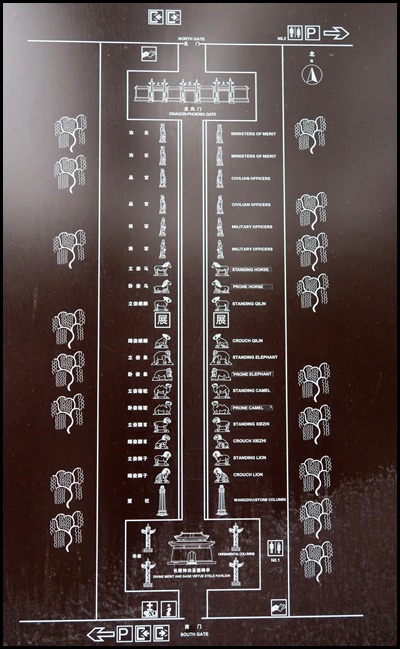 Oh Lord, another sign: The Sacred
Passage. The Changling Sacred Passage is called the chief sacred passage because
all the sacred passages leading to other tombs in the complex branch out from
here. The passage began to be constructed in the 10th year of Emperor Xuande’s
reign (1435) and then got reconstructed in the 19th year of Jiajing’s reign
(1540) of the Ming Dynasty. The Stone Archway, the Great Read Gate with
Dismounting Steles on both sides, the Divine Merit and Sage Virtue Stele
Pavilion, the Stone Sculptures, the Dragon-Phoenix Gate, the Five-Arch Bridge,
Seven-Arch Bridge (I couldn’t help it, I just shouted Bingo) and other
buildings are lined from south to north (and we are bimbling north to south
– go figure......), looking magnificent. Among the, the Divine Merit and
Sage Virtue Stele Pavilion, the Stone Sculptures, the Dragon-Phoenix Gate are
the core structures along the passage. The stone carving, gravely modeled,
accords with the solemn atmosphere of commemoration of the mausoleum complex and
achieve a very high artistic level (I need to strangle a cherry right now
as it makes a change from crushing a grape.....).
 Oh, we only did the signs and maps and
we look right to see the first gate is quite a
stroll.
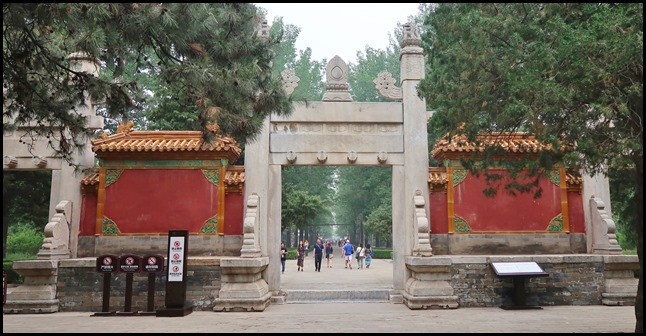 Lingxing Archway, also named
Dragon-Phoenix Gate or Arch of Flame, symbolizes the
Gate of Heaven. A carving of a flaming pearl decorates the horizontal board over
the doorway leads to the popular name “Arch of Flame”. Since the departed
emperors and empresses were carried through this gate to their burial sites, it
is named “Dragon-Phoenix Gate”.
Having now lost the will over the
signs, I stepped off the path to enjoy a cotinus coggygria or smoke bush tree.
 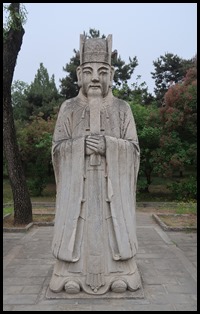 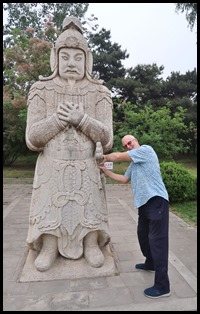 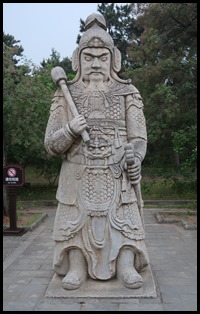 The first four
chaps were, in fact, quite impressive.
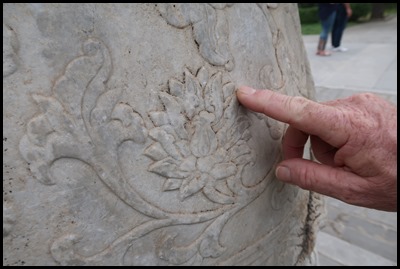 All were intricately carved all those years ago and stand through
all weathers......
 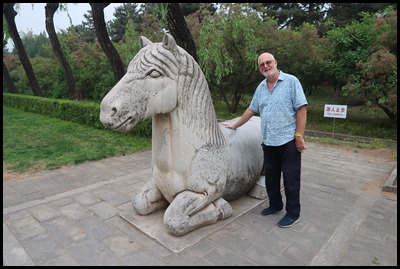 Bear leapt at the chance to pose with
each statue. A pair stands each side of the path but he skipped down the
right-hand side for each different chap. These horses
certainly have sturdy legs.
 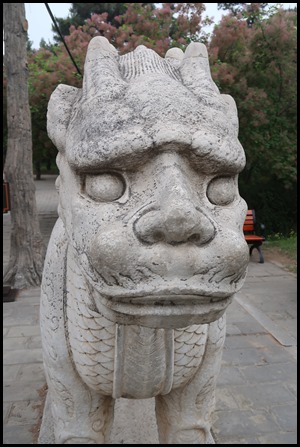 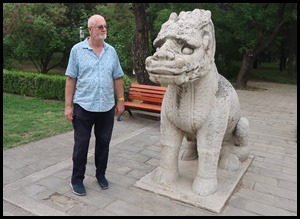 Bear still not too sure about a mythological unicorn or xiezhi.......with two horns. It’s not right and it’s not seemly, no wonder they didn’t catch on
and take the world by storm. Agreed Dear, agreed, so pleased you got
that off your chest.
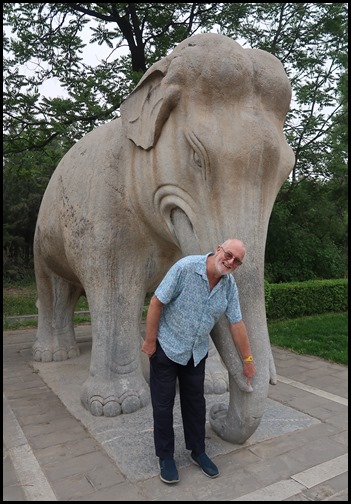 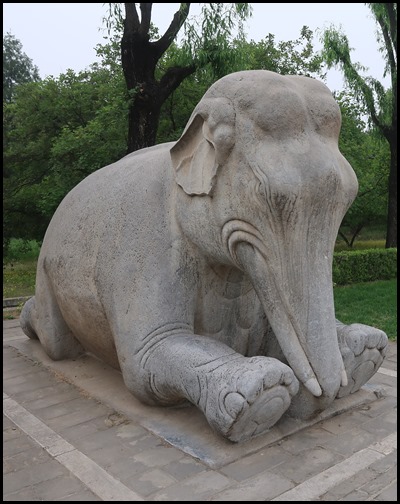 The trigger
finger came out on Nelly while his friend look
on stoically. The laying down animals take over the watch at midnight, resting
during the day whilst the standy-up chaps are on watch.
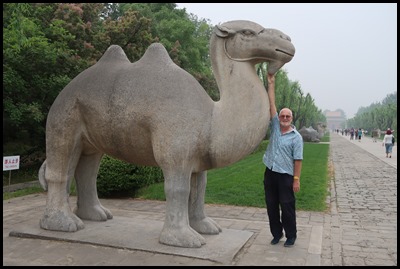 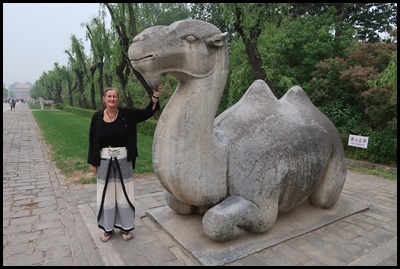 I got in on the camel kind.
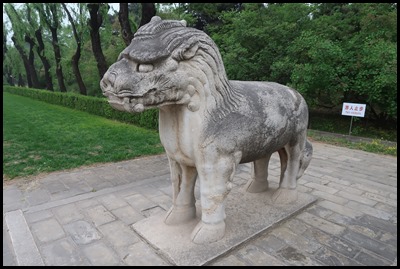 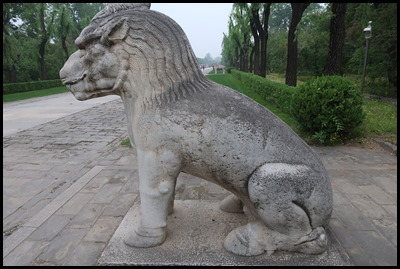 Quite noble
sorts.
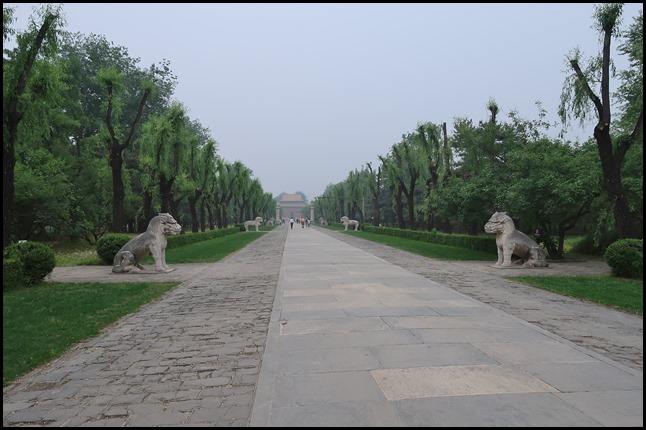 I guess we are about half way at this point down the one kilometre
path.
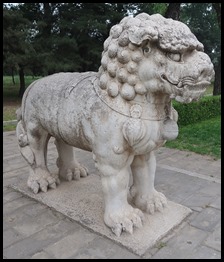 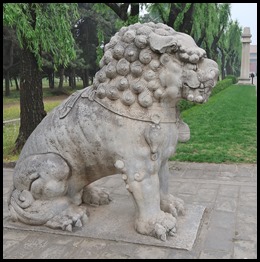  These fellas were entirely fed up with their hair-dos. “Not at all manly or in keeping
with our kind” one told me. The lions with the bad
perms brought us smoothly to the end of the guardians. Unwilling to type anymore
from information boards or pamphlets, I would this next piece on the internet.
Whoever wrote it, I am most grateful:
In the front part of the imperial
necropolises, there usually is a Sacred Way (or Divine Road) which means the
road leading to heaven. The Emperor, known as the Son of the Heaven, who came
from Heaven to his country through the Sacred Way, also deservedly would return
to Heaven through this road.
After the guardians, Bear posed and was quite concerned about the jaunty angle of this one of the two Roof Pillars on each side of the road, whose surfaces are carved with the cloud design, and tops are shaped like a rounded cylinder. .
The Shengong Shengde Stele Pavilion............
A big boy when you see Bear who just photo-bombed to the left of the picture. Lovely from the sunny side.
...........inside it, there lies a 50-ton tortoise carrying a stone tablet.
A white marble Huabiao (ornamental pillar) is positioned at each corner of the stele pavilion. At the top of each is stationed a mythical beast facing either inward or outward, expressing hope that the emperor will neither cling to the palace nor forget to return to the Palace to handle state affairs.
The analytical bit in me insisted on adding the
information board for completeness. After a wonderful time at the Great Wall and a really enjoying the
Sacred Passage, our feet declare it time to head back to our
digs.
ALL IN ALL A SMASHING BIMBLE
THROUGH THE GUARDIANS
A LOVELY, QUIET PARK-LIKE
PLACE |
